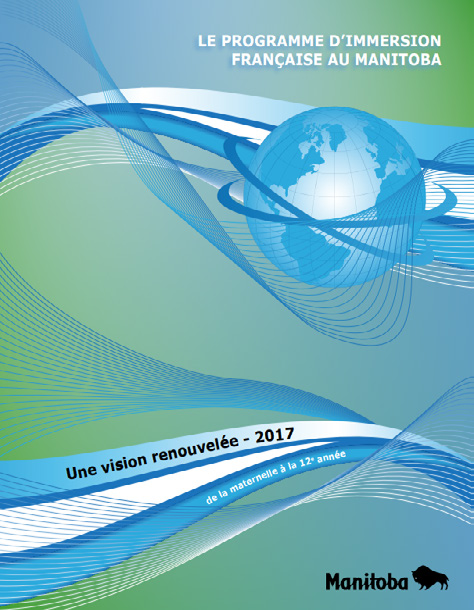French Immersion Program Overview ( 816 KB)
816 KB)
In Manitoba, the first French immersion classes began in 1973. Since 1995, Manitoba Education and Early Childhood Learning has recognized French Immersion as one of the four official Kindergarten to Grade 12 school programs, along with English, Français, and Senior Years Technology Education. In 2023, the department renewed the French Immersion Policy in Manitoba to guide the full implementation of the Program.
The French Immersion Program is, first and foremost, a language program. It prepares students to be proficient in Canada’s two official languages—French and English—to achieve academic success and to cultivate their plurilingual identity. The Program is based on the philosophy of learning language through content in authentic and meaningful academic, cultural, and social situations. The unique character of the Program derives from the fact that the French language is both the medium and the object of instruction in all disciplines.
Consequently, every teacher in the French Immersion Program is a teacher of language with the dual task of
To successfully implement the French Immersion Program in Manitoba, the following four key areas must be considered and addressed:
A French immersion school is the first and often the only space where students interact in French. The setting created in French immersion schools is the foundation necessary to ensure success for all students. The visibility of French and opportunities to use the French language throughout the school enhance students’ engagement and motivation and help them develop pride and confidence in their French language competencies.
The entire school community should support and validate students’ language acquisition by establishing high visibility and use of the French language throughout the school by all staff and students. The French Immersion Program offers an environment that fosters the development of students’ French language competency.
The following factors must be considered in order to create a French immersion setting:
A French immersion setting must value and encourage students’ experience by focusing on their pathway to becoming plurilingual. To build confidence, students strengthen their language proficiency in French through social, academic, and cultural contexts, thereby validating their linguistic experience. The French Immersion Program requires that schools provide opportunities inside and outside the classroom to enrich the French language environment for students.
In an immersion setting, the French language is both the object of and the vehicle for learning in all disciplines. Because of the transdisciplinary nature of the French Immersion Program, all staff working in the Program at all levels and in all disciplines share the responsibility for ensuring quality teaching not only with respect to the content of the discipline, but also with respect to the French language itself.
It is important that schools validate students for having chosen this path and engage them in becoming conscious of their choice when speaking and living in two or more languages and in seeing these languages as relevant to their lives. The following factors must be considered in order to validate students’ linguistic and educational experience:
French Immersion Program staff must be supported when hired and throughout their career. It is important to understand that the French Immersion Program has specific needs that differ from the English Program.
The sustainability and growth of the French Immersion Program rely on the recruitment and retention of educators with the necessary competencies: language skills, cultural knowledge, and second-language methodology. Any activities that support recruitment and ongoing professional learning for teachers ensure a strong French Immersion Program.
In addition, leaders need opportunities to keep up to date with current research and issues in French immersion and to dialogue with other French immersion leaders to address the specific needs of the Program. They are then better equipped to provide leadership in the school community.
The following factors must be considered in order to hire and support educational staff:
Recruitment and retention of French immersion students are vital to the success of this Program and are key indicators of its full implementation. This entails welcoming students into the Program and supporting them to ensure a positive French immersion experience and continued participation through to Grade 12.
Since attrition poses a challenge to program stability, a concerted effort is required to retain more students in the French Immersion Program. Monitoring enrolments and enrolment trends at all grade levels will help school divisions determine actions to be taken to improve student retention from Kindergarten to Grade 12.
A firm commitment to provide the best possible learning conditions for students contributes to the quality of the French Immersion Program and its long-term growth. Important factors that will help ensure program stability include offering multiple entry points into the Program, which ensures its visibility within schools, and implementing strategies to reduce attrition when students struggle or during transition points.
The following factors must be considered in order to monitor student enrolment:
Ensuring success of the French Immersion Program requires an active and purposeful focus on its vision and is determined by

The vision for the French Immersion Program in Manitoba lays the foundation for a program where students benefit from a rich French immersion experience and where they develop their French language proficiency, achieve academic success, and cultivate their plurilingual identity.
The goal of the French Immersion Program is to develop proud, confident, engaged, plurilingual global citizens.
The French Immersion Program enables students to interact spontaneously, autonomously, and confidently in French with pride and ease. They seek opportunities to engage in the francophone community. Their identity as Canadian citizens, competent in both French and English, creates lifelong opportunities and fosters openness to other languages and cultures.
This vision should orient thinking and decision-making, inform instruction and assessment, and guide conversations with parents and students, ensuring the full implementation of the French Immersion Program.

To successfully support students in the French Immersion Program, it is important to reflect continuously on their language acquisition, culture, and identity by asking the following questions:
It is therefore incumbent on schools to prioritize the place of language, culture, and identity within the Program.

French language acquisition is at the heart of the French Immersion Program and must be at the forefront of the minds of school leaders, educators, students, and parents. Since most French immersion students in Manitoba have little or no contact with the French language outside of the school environment, experiences that require communication in French are of the utmost importance and should be maximized throughout the school setting. Therefore, students need to participate in multiple types of interactions in French, inside and outside the classroom, which promote significant, relevant, and engaging use of the language.
Educators and students must be aware that speaking is a fundamental component of the language learning process, and that the development of oral skills maximizes learning and the effective use of French. In the classroom, French immersion educators therefore focus on French language learning and oral proficiency throughout the day and in all subject areas. Hence, French language learning becomes as much a priority as the learning of the subject matter. French immersion practices integrate language instruction and content-area instruction. Students learn the French language, they learn about the French language, and they learn through the French language. For all subjects taught in French, students need to have equal opportunities to speak, listen, read, and write in order to develop their language proficiency and confidence. The more students develop their language competencies in the classroom setting, the more they develop greater understanding of the content.
Every teacher in the French Immersion Program is a teacher of language with the dual task of teaching subjects in the target language and ensuring ongoing learning and sustained use of French in the classroom.

For French immersion students, school is not just a place where they spend time and learn but also a cultural and linguistic milieu. It is an environment where they feel valued in their culture of origin, as well as in their emerging linguistic and cultural identity. This environment becomes a place where students can build a repertoire of socio-cultural referents, acquire the cultural values conveyed by the French language, and enjoy rich experiences that will enable them to develop their plurilingual identity.
In order for students to discover and share in Francophone culture, they must have multiple opportunities to interact with Francophone communities so that they become familiar with Francophone cultural referents: local, national, and international.
Mindful of the Francophone minority context, the school assumes the responsibility of exposing students to various cultural resources of the Francophone community (e.g., people, songs, plays, shows, books, programs, etc.) in order to create a multitude of referents, images and values associated with Francophone cultures. Students are encouraged to participate in and contribute to la francophonie, thus nurturing the development of their cultural and intercultural competencies.
The more students understand these referents, the more they develop a connection with the language and culture and a greater sense of belonging to the Francophone community. This also allows students to broaden their cultural perspectives, both as a form of personal enrichment and as a means of better understanding themselves and others. Language learning and building a plurilingual identity go hand in hand when cultural referents are valued and integrated in the school community.

All students enter school in the French Immersion Program with their own unique identity. This multidimensional identity develops through family, friends, community, the groups they belong to, languages spoken at home, culture, beliefs, values, and experience. Supported by their parents who validate their French immersion experience, students see their identity evolve. The students’ identities are constructed and refined continuously based on their interactions with their environment and the people around them.
Throughout their schooling in the French Immersion Program, students are called upon to reflect on the essential questions—Who am I? Where do I come from? Where am I going? What do I want to become? Who have I become?—in order to know themselves better.
According to John Ralston Saul, immersion students are part of a new Canadian collective, a growing minority that are neither solely francophone nor solely anglophone. It is important to promote this « other identity » and to guide and support learners in developing an awareness of the impact of the French language on their learning and on the person they are, and in this way help them value their constantly evolving identity. Students will then be able to take their legitimate place in the Canadian bilingual community.
It is therefore incumbent on educators to have students reflect and talk about their language learning experiences by having them share their emotions, their concerns, and their successes. Students need to be commended and encouraged to go further by taking responsibility for their language learning and for living as plurilingual citizens.
French Immersion schools are the first and often the only francophone environment in which students interact. It is important to create a francophone environment with a vitality that is maintained by the entire school community. Each stakeholder plays a key role in the development of this environment, where language, culture, and identity are interrelated. Educators are called upon to share their own engagement with French-language and Francophone cultures, and share their identity as plurilingual learners or speakers. As educators share their personal pathway of living their plurilingualism, they also guide students to find their own pathway.
Students, placed at the centre of learning within this francophone environment, co-construct their identity and experience its evolution through rich and varied social, cultural, and academic interactions in each curricular area and in the school community. These interactions promote significant, relevant, and engaging use of the language and participation in various cultural experiences, enabling students to develop their identity as proud, confident, engaged, plurilingual global citizens.
Important:
The French Immersion program courses are only available in French.
To access the content, select one of the courses below. You will automatically be redirected to the corresponding French version.
As curriculum alignment to the new structure continues, the following courses remain at their original locations and can be accessed by clicking on the tiles below.